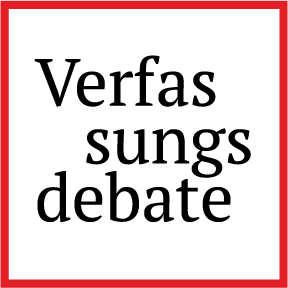We the Bugs
Constitutionalizing “Enemies”
On April 14, 2025, the Hungarian parliament passed the 15th Amendment to the Fundamental Law, triggering mass protest across Budapest. Amongst its most far-reaching provisions is the constitutional entrenchment of binary sex. Read alongside a reworded Article XVI, which affirms that “every child has the right to the protection and care necessary for his or her proper physical, mental, and moral development”, these provisions establish a new hierarchy of fundamental rights, placing child protection above all others – including the right to peaceful assembly – with the sole exception of the right to life. Crucially, they may now lend formal constitutional legitimacy to discriminatory legislation, including the law adopted alongside the amendment seeking to ban Pride Parades.
Its timing appears far from coincidental: the government introduced it just days before Prime Minister Viktor Orbán’s controversial speech on the national day commemorating the 1848 revolution. In that speech, Mr. Orbán launched a sweeping attack on political opponents – including journalists, political activists, civil society organization members, and even judges – declaring that, in the spirit of the “Easter cleaning”, the country must rid itself of the stinkbugs (büdös bogár, poloska) that had survived the winter.
The changes represent a significant escalation in the Orbán regime’s ongoing effort to enshrine its political “enemies” within the very fabric of Hungary’s constitutional order. Though couched in Christian-orthodox rhetoric around family, child protection, sovereignty, and national identity, the provisions are, at their core, politically charged and authoritarian in nature. This is reflected, not least, in its clear departure from the protection of human rights and fundamental freedoms under the European Convention on Human Rights (ECHR).
A new hierarchy of fundamental rights
One of the main aims of the 15th Amendment was to deliver on a promise made by the Prime Minister in his annual State of the Nation address, in which he declared:
“We […] have protected our children from gender activists […] We must not give up on protecting our children. […] Let us write into the Constitution that a person is either male or female. Full stop. In fact, I advise the Pride organizers that they should not bother preparing for this year’s parade. It would be a waste of time and money.”
The Preamble of the Amendment echoes this rhetoric, affirming that “a person’s birth sex is a biological endowment, which can be either male or female […]. The fixity of biological sex ensures the healthy development of society and the maintenance of basic community norms.” Its purpose is to establish that “the Hungarian legal system does not recognize any change of sex at birth”, thereby “preserving the stability of the institution of family and the security of the social order.”
Accordingly, the new Article L (1) of the amended Fundamental Law now determines that “a person is a man or a woman”. The full purpose of this entrenchment of binary sex becomes apparent only when read alongside a reworded Article XVI, which affirms that “every child has the right to the protection and care necessary for his or her proper physical, mental, and moral development”. Together, these provisions establish a new hierarchy of fundamental rights, placing child protection above all others – including the right to peaceful assembly – with the sole exception of the right to life. This normative hierarchy, combined with the constitutional entrenchment of binary sex, may now confer formal constitutional legitimacy on discriminatory legislation – including a new lawadopted alongside the amendment aimed at “protecting children from assemblies that promote homosexuality”. Though framed as a general restriction on freedom of assembly, the law is almost certainly designed to target Pride Parades in particular. It has been examined in greater detail in previous posts on this blog.
Violation of EU standards
The Amendment clearly violates international and European standards of the Rule of Law. By defining human beings as either male or female, the Amendment effectively prohibits the legal recognition of gender identity in a discriminatory framework. This violates the rights of transgender people, which, on its own, amounts to a breach of the ECHR. In Goodwin v. U.K. the European Court of Human Rights (ECtHR) held that states must allow for changes of birth registration when a person’s gender identity does not align with their sex assigned at birth. In E.B. v. France, the ECtHR required that states not discriminate based on sexual orientation and sexual identity. Indeed, discrimination on the basis of sexual identity has constituted a clear violation of EU law for nearly three decades. And recent interpretations also provide protection for European citizens in the realm of data protection. The Court of Justice of the European Union ruled in a judgment on 13 March 2025 that EU Member States must allow gender marker changes as a matter of data protection rights.
The reconfigured hierarchy of fundamental rights and its explanatory basis also ignore European guidelines. The government argued, for example, that protecting children and upholding traditional Christian conceptions of the family could justify a restriction on the freedom of assembly, postulating an alleged link between Pride parades and the violation of children’s rights. This form of argument is not new: When the government tried to invoke a similar justification in 2020 concerning its Act on the Protection of Children (Act XXXI of 1997, Article 6/A) – a law that ultimately caused discriminatory effects for LGTBTQ+ people who had been excluded from the possibility to adopt children – the Venice Commission and the European Parliament clearly rejected the Hungarian government’s reasoning and asserted that the measures discriminated against and stigmatized LGBTQ+ people. In Macaté v Lithuania, the ECtHRalso denied that there is any “link” between pride parades and threats to children, holding that there is no scientific evidence or sociological data at its disposal suggesting that the mere mention of homosexuality, or open public debate about sexual minorities’ social status, would adversely affect children. Instead, it affirmed that it is a lack of information and the continuing stigmatization of LGBTQ+ persons in society which is harmful to them.
Further Insulation
Importantly, the amendments may also provide a basis for the Hungarian government to insulate itself further from precisely these European pressures. Article E (2) of the Fundamental Law states that Hungary may, “to the extent necessary to exercise the rights and fulfil the obligations deriving from the Founding Treaties”, exercise some of its competences arising from the Fundamental Law jointly with other Member States, through the institutions of the European Union. Exercise of competences under this paragraph, however, should “comply with the fundamental rights and freedoms provided for in the Fundamental Law” and “shall not limit the inalienable right of Hungary to determine its territorial unity, population, form of government and state structure.” Entrenching the Amendment’s discriminatory provisions in the Constitution may thus allow the government to keep on playing the national identity card in the forthcoming legal debates between the EU and Hungary. By openly framing LGBTQ+ people as a threat to children and entrenching this narrative in a normative hierarchy of rights, the government comes one step closer to constitutionalizing its constructed “enemies”. Again, this will be particularly consequential in constitutionally legitimizing discriminatory laws such as those attempting to restrict Pride Parades.
In Broad Daylight
The Amendment’s Preamble states that the “Western world is increasingly attacking norms that were previously taken for granted, especially the institution of the family and national identity”. With the new Amendment and the related legislative changes concretizing its provisions, however, the Orbán government’s motivations seem far from being able to convince EU institutions of the importance of the traditional Christian family model or conservative values.
Instead, they mark yet another pivotal step in the Orbán regime’s longstanding strategy of constitutionally entrenching its perceived political “enemies”, including those whose freedom to self-expression and self-determination it is threatened by. Using the Constitution to construct and threaten such “enemies” – including civil society, those critical of government actions, and other minorities – has been an essential element of the Hungarian regime’s strategy since its beginning 15 years ago. This strategy has, over time, followed a deliberate logic of gradual escalation. While the government first started targeting “foreign enemies”—such as migrants, Muslims, or George Soros – it is now clearly turning toward and constructing a narrative of the “enemy from within”.
With this new amendment, this is now formally enshrined in the very fabric of the Hungarian constitution. This current one-party constitution has, since its amendment in 2010, not served as an expression of a genuinely pluralist, democratic popular sovereign. Instead, it has been a constant tool for the construction of “‘enemies” and the disunification of its pouvoir constituent. The 15thAmendment marks a new point of departure because the Constitution now not only disunifies its popular sovereign but expressively excludes its internal “enemies” with unprecedented force and rigor. It has become clear that Orbán’s government is not afraid of targeting its own citizens in broad daylight.
The author expresses his gratitude to Petra Bárd and Gábor Halmai for their valuable comments on a draft of this piece.
Research for this post was supported by a Grant from the German-Israeli Foundation for Scientific Research and Development (GIF, Grant number 1557).



